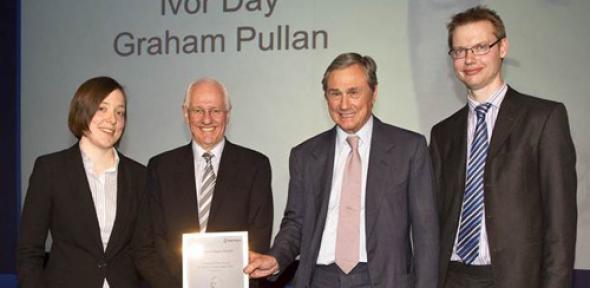
A trio from the Department of Engineering have been awarded the newly-instituted Rolls-Royce Howse and Ruffles Award for the Best Doctorate Paper. The prize was presented to Anna Young, Ivor Day and Graham Pullan by the Rolls-Royce Chairman, Sir Simon Robertson, at the recent Sir Henry Royce Awards ceremony in Burton-upon-Trent.
The work was undertaken at the Whittle Laboratory where Anna is the Pembroke College Maudslay-Butler Research Fellow, Ivor is a Rolls-Royce Senior Research Fellow and Graham is a Lecturer.
The paper was based on Anna's PhD work on a warning system for stall (the aerodynamic failure of a jet engine compressor) which was supervised by Ivor.
Anna explained her work: "Stall can lead on to surge, which causes extensive engine damage. The dangers associated with surge necessitate a trade-off between safety margin and efficiency. This means that the compressor is held back from operating as well as it could, and so fuel burn is increased.
"Despite much research over the past 65 years, there is no consistent model for stall onset. The approach we took was to take a step back from the actual stalling process and consider whether there is any warning preceding this dangerous flow condition. This approach came from the observation that the noise made by a compressor changes tone as the danger point is approached.
"Our work showed that the noise made by the compressor increases in intensity as surge is approached, but that the change in tone is governed by the size of the tip-clearance gap and the eccentricity of the casing. Gap size and eccentricity will both change several times during each flight cycle. The current work shows that the concept of using the change in tone for stall warning is based on inadequate understanding and such a system will not work under all operating conditions."
The research not only quantified the change in tone in a compressor, but also led to the positive identification of a new form of disturbance, which is the actual cause of the noise observed. The discovery was based on a new data analysis technique and very detailed measurements in the vicinity of the blade tips. The work was initially presented at the American Society of Mechanical Engineers' (ASME) conference in Vancouver in June 2011, and received a best paper award there.
The work led on to further work by the same authors along with Professors Edward Greitzer and Zoltán Spakovszky at Massachusetts Institute of Technology (MIT). In this work, careful analysis of back-to-back computational and experimental tests enabled groundbreaking physical insight into the stalling process itself. This work has also been recognised with an ASME best paper prize.

